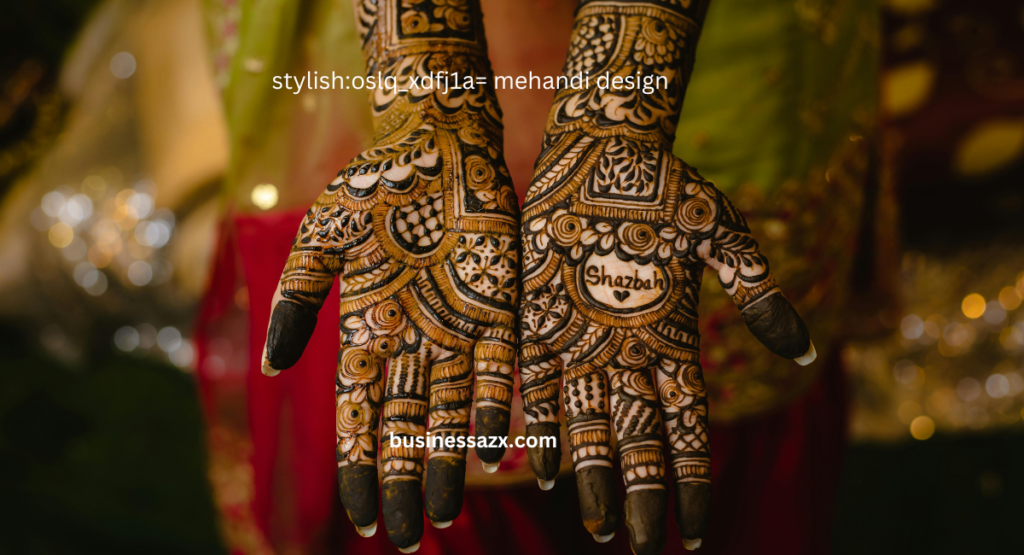stylish:oslq_xdfj1a= mehandi design is more than just a cultural aspect or designing thing, it is a way of life and creativity rolled into complex styles that inform precise stories. From sensitive floral motifs to ambitious geometric shapes, every design displays the character and options of the wearer.
Read Also: EnnuiFans: The Ultimate Platform for Unique Content Creators
Imagine taking walks into an occasion where your palms are decorated with fashionable swirls, lace-like designs, or maybe contemporary art-inspired styles which might be sure to trap every eye inside the room. What makes a mehandi design stylish is its potential to blend way of life with present day influences.
Introduction to stylish:oslq_xdfj1a= mehandi design
Mehandi, in our normal tongue is called henna. It is used for making desings according to different occasions and for its cooling effects. Intricate styles and designs are drawn onto the hands and feet. The usage of natural henna paste had been a part of various cultures for centuries, especially in South Asia, the Middle East, and North Africa. In this article, we will explore history, and guidelines for creating fashionable and stylish mehandi designs.
History of stylish:oslq_xdfj1a= mehandi design: Origins and Cultural Significance
Mehandi or Henna has been under usage since 5000 years, while its initial origins are traced to ancient India and Egypt. In these cultures, henna was used to adorn the bodies of brides and royalty, symbolizing beauty, and joy. Traditionally, mehandi designs were applied according to the festival, and rituals of weddings, non-secular celebrations, and rites of passage.
For example, in India, mehandi is a necessary part of the pre-wedding ceremonies, in particular throughout the mehndi ceremony, where complex designs are implemented to the bride’s fingers hands, arms and toes. The artwork is assumed to deliver affection, prosperity, and happiness to the wearer. In the Middle East, henna is associated with protection from the evil eye, even as in North Africa, it’s seen as a symbol of fertility and protection.
Though its cultural meanings vary throughout areas, the procedure of making use of mehandi continues to be a deeply significant ritual that connects humans to their history and community.
stylish:oslq_xdfj1a= mehandi design: Types of Mehandi Designs Explained
stylish:oslq_xdfj1a= mehandi design are versatile and are available in many patterns. They vary according to the area and their traditions. Here are few famous types of mehandi designs which are generally used in every area;
Traditional Mehandi Designs
On the first number of mehandi designs, we have traditional mehandi designs. They are the most classic and simplest styles of mehandi. They feature motifs like paisleys, flowers, vines, and mandalas.
Arabic Mehandi Designs
Mostly used in Arabic regions. They contain flowing traces and minimalistic styles. These type of designs generally contain large floral motifs and shapes.
Indian Mehandi Designs
Most famous designs in the category of stylish mehandi designs are Indian Mehandi Designs. Indian mehandi consists of delicate, nice traces, difficult floral styles, and henna motifs.
Modern Mehandi Designs
As mehandi artwork evolves, many artists create revolutionary designs that blend traditional motifs with present day elements. These designs may additionally contain space, minimalism, and particular color combinations.
Bridal Mehandi Designs
Bridal mehandi is the most complex of all. It contains thick patterns and is used widely during wedding events.
stylish:oslq_xdfj1a= mehandi design: Popular Patterns for Modern Celebrations
The most popular patterns of mehandi designs include floral patterns, mandala designs, simplest designs, jewelry inspired designs, Peacock and Bird Motifs.
Steps to Choose the right stylish:oslq_xdfj1a= mehandi design
- The design you select should resemble according to the event or occasion. For weddings and formal celebrations, thick and complex designs are opted. For Diwali and Eid festivals, lighter tone designs are selected.
- Pick a layout that resonates with your personality. If you like nature, floral designs; for a contemporary twist, geometric and minimalist styles will be more fitting.
- More complex designs take longer to use. Consider how much time you have got for it, especially for weddings or big events.
- Lighter skin tones can also gain from darker, bolder designs, even as darker pores and skin tones regularly complement extra special and sensitive patterns.
Maintaining Your stylish:oslq_xdfj1a= mehandi design Longevity
To make sure that your mehandi lasts as long as possible, follow those aftercare recommendations:
- Avoid Water; Keep the layout faraway from water for the first 24 hours to let the stain increase fully.
- Apply herbal oils and moisturizers to preserve the color.
- Avoid scratching or rubbing. The designs of mehandi gets faded away if scratched or rubbed.
Professional vs. DIY stylish:oslq_xdfj1a= mehandi design: Pros and Cons
| Professional | DIY |
| Pros: They are much experienced. They can create stylish design within few minutes. And have the ability to draw difficult patterns. | It is cost effective and budget friendly. Allows creativity and natural invention of new design patterns. |
| Cons: They are costly. Pre-booking is also needed sometimes. | Takes time to draw patterns. The layout may be not as much precise as it can get with professionals. |
Conclusion
stylish:oslq_xdfj1a= mehandi design are best way to enhance your overall look and change your appearance according to the occasion. The cooling effect of mehandi is also commendable.
